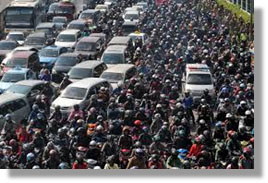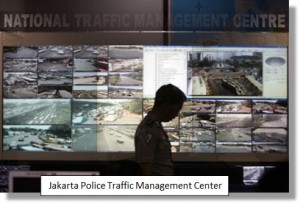Social Media and Public Safety Communications—Jakarta Police Provide a New Approach
How to appropriately address the explosion in social media communications within an emergency communications environment is a concern for Public Safety Answering Points (PSAP) throughout North America. A different approach for emergency communications center to utilizing social media to communicate with the community was found literally half-way around the world in Jakarta, Indonesia.
The Jakarta, Indonesia Police or the Metro Jaya Polda may provide a view into the future for emergency communications centers and the use of social media. The Jakarta Police use their Traffic Management Center (TMC) as the center for their two-way social media communications with the Jakarta residents as well as for providing emergency response. The TMC example potentially provides a new standard for using social media communications in an emergency communications center.
Started Social Media Program 18 months ago
The TMC started its social media communications program 18 months ago. Already, it has over 275,000 Facebook Friends and over 1.29M Twitter followers. Also, the Center receives Instagram photos on a continual basis, over 8,000 in the past 6 months. The TMC staff also answers 2,372,500 text messages annually.
The TMC makes significant use of Social Media for communicating with the public. Also the use of SMS 1717 is used to update travel information through Traffic Management Center (TMC) and it is utilized by Metro Java Operations to report crime and ask questions of officers on the streets.
 Traffic is a Major Public Safety Issue in Jakarta
Traffic is a Major Public Safety Issue in Jakarta
It’s no wonder that the TMC has become the focal point of communications between the public and the police. Traffic management is a major problem in Jakarta and in most developing countries. With over 1.5 million new vehicles being registered each year in Jakarta, the road infrastructure is quickly reaching the saturation point. Compounding the problems with the road infrastructure limitations is the fact that Jakarta is the national capital, where daily demonstrations for multiple causes occur, just like Washington, DC, hindering traffic further. The level of road congestion is not only a major public safety concern, but also a major source of public angst. The TMC provides a focal point in the city for dealing with issues that impact all city residents.
What is the Driving Force?
Considering that 60% of Indonesia’s population is under 30 years old, social media is a primary and routine method for people to communicate. Making the TMC’s social media communications initiative in step with how many members of the community communicate already.
In the US, according to a Pew Research Foundation report, eight in ten online US teens use some kind of social media, 95% of those between 12-17 years old use the internet. Facebook attracts 77% of online teens. Twitter is gaining steadily as a major source of communications for teens. Over 24% of teens now use Twitter up from 16% in 2011 and 8% in 2009 and 16% of US adults are Twitter users. This trend is continuing on an upward slope for the past 5 years and is continuing to grow in the US and Canada.
Social Media’s Impact on the TMC
As the TMC has evolved the use of social media to communicate with the community over the last year, so have the TMC’s operations floor layout, staffing and systems. The TMC has six 24X7 social media and text related workstations. In addition, the Department started a new emergency communications service this year using “110” as the emergency number, in collaboration with Telekom Indonesia (TI). The TI managed 110 call center transfers over 150 emergency calls per day to the TMC. This will increase, based on the future plans of the TMC and Metro Polda leadership to include the TMC in the future 110 emergency communications system and centers.
TMC Emergency Call Taking and Dispatching Operations
In addition to the TMC and managing traffic flow and incidents, the TMC is the dispatching center for Traffic Police throughout the province. The 110 call center transfers all traffic related calls to the TMC for dispatching. So, in addition to text, social media and of course traffic monitoring operations, emergency call taking and dispatching is performed in the TMC. The TMC has three 110 call taking positions and three radio dispatch positions. The TMC dispatches officers, on average, to over 125 incidents daily. During April, 2013, the TMC dispatched traffic officers to nearly 4,000 incidents.
Link between emergency communications and traffic management
Our team interviewed LTC Sambodo, Deputy Director of TMC and his staff on the current capabilities and future plans for the TMC. We also conducted a detailed visit of the TMC. The mission of the TMC is to support street-based traffic police officers, communicate with the public on traffic related issues, dispatch traffic police to incidents and coordinate with Provincial Traffic Management Center control and manage traffic flow throughout the province.
The highest volume of non-voice communications between the TMC and the public is through text. The TMC has three positions dedicated to support text from citizens, either SMS or MMS. This position receives over 6,500 text messages daily. The text messages range from traffic information to requests for DMV information to traffic laws and regulations.
Officers also validate text information before sending it to dispatch. The TMC advertises the use of “1717” to answer multiple motor vehicle questions by city residents. The Indonesian Police provide motor vehicle licensing, registration services across the country through its Traffic Police Division. The TMC will also forward social media message to field personnel to provide incident information.
TMC Recognition—FutureGov Award
The Jakarta Police TMC was recently recognized by FutureGov for the 2013 award for “Citizen Engagement” for its current operations. This award was specifically related to the work of the TMC for communicating with the public on traffic issues.
Future Plans for integrated traffic – emergency communications and dispatch center
The TMC management has a vision of the future TMC, its systems, inter-relationships and operations. The vision describes a number of key initiatives and activities that will enhance traffic management within Jakarta as well as support improved traffic management. The vision and associated initiatives are incorporated in a brochure distributed by the Traffic Police.
The future vision includes integration between several key facilities and operations within the province. The vision includes the integration of the TMC into future Jakarta Police Department 110 center.
Lessons for North American Emergency Communications
According to Everbridge, a recent survey of over 400 emergency communications planners, over half (58%) said they do not yet have plans to use social media in an emergency. Yet, during recent disasters in the US such as Hurricane Sandy, the public is using Social media to communicate with each other, the media and emergency management centers. During Sandy, over 300,000 photos uploaded using hashtags such as #sandy, #hurricanesandy, #frankenstorm. Not necessarily going to 911 centers.
As seen from the Indonesian example, public safety communications centers can become the central focus of the public’s communications with public safety through social media. The Jakarta example also indicates that it may not take long or extensive efforts to advertise and implement a social network emergency communications linkage. In 18 months, with limited budget and advertising the Jakarta Police TMC’s social media communications operation has expanded well beyond anyone’s expectation. They hit on a pent up demand from the community that was already using social media instead of voice communications to obtain information and services from emergency responders.
North American social media users are not limited to teenagers. Over 73% of Baby Boomers according to a Deloitte survey, maintain a Facebook profile. Other data shows that 77% of Millennials and 61% of Generation Xers maintaining social media profiles. Of course, seniors are not to be let out, with many using Facebook as a new hobby. According to “Buffer,” 67% of all Internet users are using social networks.
So, the “market” for emergency communications to connect with social media users is here. What are not available is the linkages to the PSAPs or public knowledge. Many PSAPs and public safety agencies have set up Facebook profiles but it is generally a one-way street. Jakarta has definitely made it a two-way street communication with the public. To start, Jakarta just advertised the service and set up a workstation—that evolved in to nine work stations to keep pace with the demand in 18 months. Something to think about.
About the Author
Jeff Winbourne is CEO of Winbourne Consulting, LLC. Winbourne Consulting is a member of the IPST Indonesia team that is preparing a 5-Year Master Plan for public safety services and systems in Jakarta, working with the Indonesian National Police and the Jakarta Metro Jaya Polda as well as the Jakarta Governor’s Office which manages fire, emergency medical and disaster management services I the capital city.


